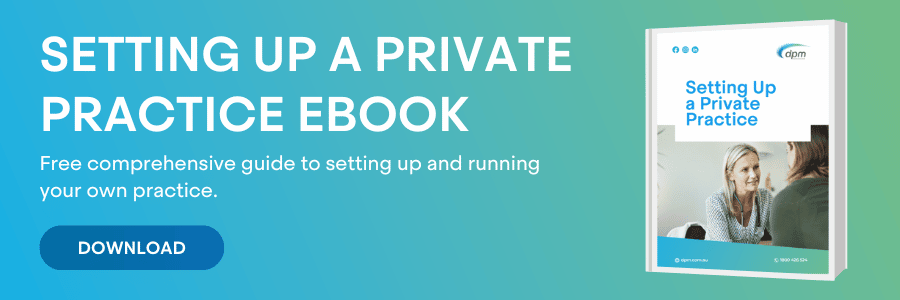Setting up a private practice – a new Australian medical practice, can be a daunting undertaking. Certainly there is a significant amount of responsibility that comes with looking after the health of a local community alongside the added responsibilities of employing staff and the financial and personal risks of running a business.
It’s therefore imperative for medical practitioners to plan well in advance to ensure that their medical practice can be successful.
This checklist is designed to help make the process of setting up a private practice more intuitive and highlights some of the key items you should consider before making the move, including:
- Making your business compliant – financially, legally and with the right insurance in place;
- Finding the right premises;
- Designing the look of your practice; and
- Employing staff and acquiring appropriate technology.
Why would you want your own private practice?
Before you launch into this checklist let’s first look at some of the major benefits to running your own practice and why you may want to commit to such a big project.
- More control over your patients’ health care experience: when you are at the helm you can make real improvements to the way people are treated and potentially to the bills they pay.
- More control over your time: you can decide how many patients you see, when you see them and every aspect of how the practice operates.
- Build a team you are proud of: taking charge of hiring staff is a big responsibility but it also means that you can design your own team.
- Enrich your community: all local areas need medical care. By taking on this responsibility you’re becoming a key figure within your community. As a result, you can develop fantastic relationships with your patients and be a force for good within your locality.
- Investing your time into your business: you always know that you’re contributing to a project that you care about.
The checklist for setting up a Private Practice in Australia
1. Get your business requirements in order
Ultimately, a medical practice is the same as any Australian business, and in the government’s eyes this means it must comply with the same legal and regulatory requirements. In order to operate as a new business in Australia you must:
- Get an ABN: an Australian Business Number via the Australian government business site.
- Register your business name: this can be done via ASIC Connect. It’s worth checking the ASIC business registry first to make sure that your name of choice is not already taken.
- Consider trademarking your logo: this can help to protect your brand as you grow.
- Set up payroll: this must incorporate mandatory superannuation guarantees.
- Comply with tax conditions: these will vary depending on your region and can be best understood by talking with an expert in the field.
As a medical provider you will also have to register with Medicare. Specifically you will need:
- A Medicare provider number;
- A Medicare prescriber number; and
- Any other registrations or licences that may apply within your state and territory.
Bear in mind that if you’re intending to have multiple premises you will need a provider number for each separate location.
2. Insurance
All businesses involve risk, and when people’s health is involved it’s even more important to protect your livelihood and reputation. There are two broad categories of insurance types that you should consider when setting up your medical practice. These include:
Insurance for businesses:
- Business expense insurance,
- Practice indemnity insurance,
- Life insurance for business partnerships,
- Management liability insurance, or
- Network security and privacy insurance.
Personal insurance
- Income protection insurance,
- Life insurance,
- Trauma insurance, or
- Total and permanent disability insurance.
3. Finding the best location
The best location for a new medical practice will take into account a number of factors, notably your local demographics, cost and business competition.
Demographic-wise, it’s useful to think about where your intended patients live, and what health conditions are most prevalent as a result of age, environment or common employment. Basing your premises near your target market is crucial for success.
It’s also important to see what other medical facilities are available in the area and whether you will be able to succeed alongside them. Increasingly in urban areas, property prices may be a serious consideration.
Alongside these factors, when setting up a private practice it can be useful to think about:
- Low maintenance – having work done on the building or grounds is both disruptive and expensive.
- Accessible by public transport.
- Low competition, from other practices and also for property prices.
- Sufficient car parking.
- Visibility.
- Good disability access.
- Capable of expansion.
- Minimal town planning issues, such as car parking restrictions.
- Adaptability of the buildings.
- A single-storey building for ease of access.
- A growing patient base.
- Presence of complementary health services and potential referrers.
4. Designing your medical practice
Once you have acquired the perfect consulting space, it’s important that you put some thought into the design and layout. For example, you may need to think about things such as:
- Specialist equipment: Ensuring there’s enough room and proper safety practices for any equipment needed such as X-rays or blood tests.
- Temperature control: Large rooms will be more difficult to maintain at the right temperature. Working out an optimised system of temperature flow can help make for a more efficient practice.
- Proper signage: Clearly visible signage will help patients, and visiting clinicians to easily navigate their way around your premises.
- Patient facilities: Making sure that patient areas are the right size and have easy access to facilities such as drinking water and toilets.
5. Acquiring software and supplies
Reliable technology and trusted medical software is now an essential requirement for modern medical practices. Technology systems will enable you to quickly and efficiently:
- Schedule patient appointments.
- Keep track of finances.
- Deal with invoices.
- Create an option for online bookings and consultations.
- Manage payments.
6. Hiring qualified and caring staff
The team you hire will set the tone of your business. Gathering the right mix of experience, qualifications and attitude will shape the place that you work in every day and define the support your business receives. This can be particularly challenging as medical practices may require a broad mix of skill sets, from receptionists and cleaners to GPs and nurses.
When undertaking hiring remember to consider:
- Skills and qualifications that may be useful.
- Personalities and how they will interact with others in the practice.
- Attitude – remember that skills can be taught, but a positive attitude is priceless.
DPM has over 50 years’ experience assisting medical professionals at every step of their career. Through extensive knowledge of the journey of a medical professional, we provide an integrated solution that helps educate doctors of Australia to make the right financial decisions and achieve their personal and professional goals.
To learn more about how we can help you in setting up a private practice, get in touch with our team today.
Disclaimer: * The information contained in this site is general and is not intended to serve as advice as your personal circumstances have not been considered. DPM Financial Services Group recommends you obtain personal advice concerning specific matters before making a decision.






